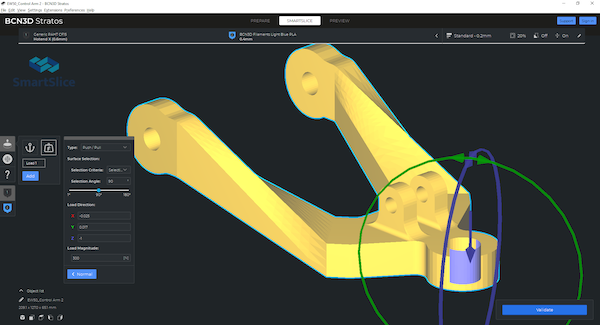Teton Simulation Tackles 3D Printed Part Performance
Via a new partnership with BCN3D, Teton Simulation is embedding its SmartSlice software as a plug-in to virtually simulate as-printed parts.

SmartSlice for BCN3D Stratos helps eliminate costly print-test-redesign cycles while optimizing printed part performance. Image Courtesy of Teton Simulation.
September 16, 2021
As 3D printing evolves into more advanced workflows, part performance becomes a critical factor in whether AM has the muscle and means to efficiently handle production-grade applications.
Teton Simulation is taking aim at that challenge with SmartSlice, its 3D printing simulation software aimed at optimizing print cycles and part performance. In its latest effort to expand the power of SmartSlice to a wider audience, the company has entered into a partnership with BCN3D to embed its slicing software into the firm’s line of 3D printers. A SmartSlice plug-in will be available to enhance BCN3D’s existing Stratos slicing software, delivering capabilities for simulating the as-printed part. This helps to optimize slice settings to minimize print time and material use while preventing unforeseen breakage—all critical milestones for establishing additive manufacturing as a viable production method, competitive with other processes.
“We’re no longer printing components for show, but instead, parts that need to function in a real-world environment, which means they can not break,” explains Doug Kenik, Teton Simulation’s CEO. “As of now, most manufacturers do not have confidence their part will behave as intended after printed (as in not break).”
Due to these concerns, Kenik says engineers typically do two things: Print the part as solid, which means the part is overdesigned with materials and time wasted, or get stuck in an unproductive cycle of iteration. “They print the part, put it into service and tweak print settings such as infill density, number of walls or infill patterns all using tribal knowledge until they get it right,” he explains. “This is a huge waste of engineering time, printer time, and material use.”
SmartSlice embeds directly into a printer manufacturer’s slicers to bring efficiencies to this process and help users gain confidence that their 3D printed part won’t break once printed. SmartSlice virtually simulates the performance of the as-printed part by working with the slicer to understand how the part is printed; it then provides guidance on the optimal settings that will minimize print time and material use while ensuring the part won’t break.
Thanks to the BCN3D partnership, SmartSlice will be pre-installed on the BCN3D Stratos slicer, and BCN3D customers will receive a free trial as part of their account. The SmartSlice materials database supports a variety of BCN3D Filaments, allowing users to virtually qualify a material for structural applications prior to purchase.
By optimizing print parameters for performance demands and manufacturing efficiency, BCN3D users will ensure an higher ROI on projects by saving hours and print-break cycles along with use of less materials. While savings vary depending on the part and use case, Teton Simulation estimates the average SmartSlice user enjoys greater than a 30% reduction in print time and material usage.
Watch this video to learn more about SmartSlice.
Subscribe to our FREE magazine, FREE email newsletters or both!
About the Author
Beth Stackpole is a contributing editor to Digital Engineering. Send e-mail about this article to [email protected].
Follow DE





